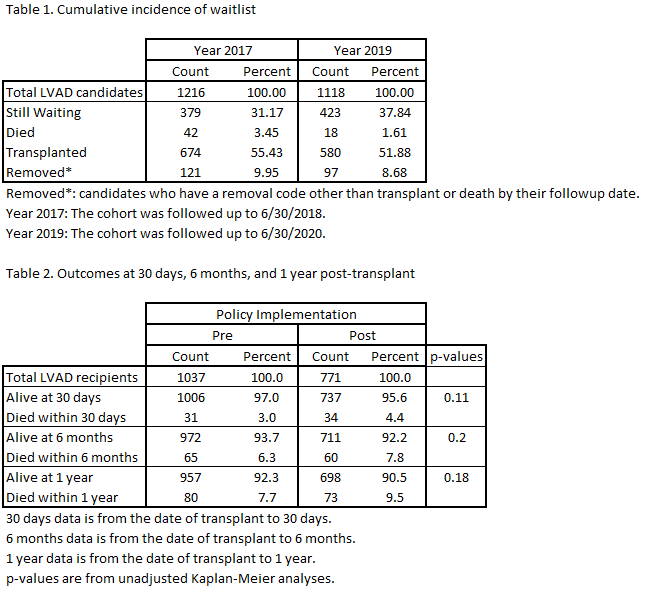Waitlist and Post-Transplant Outcomes of Candidates With Lvad: Comparison of Old and New Heart Allocation Policies
1Univ of Michigan, Ann Arbor, MI, 2SRTR, Minneapolis, MN, 3Baylor Univ, Dallas, TX, 4St. Vincent Heart Ctr, Indianapolis, IN
Meeting: 2021 American Transplant Congress
Abstract number: 47
Keywords: Allocation, Heart assist devices, Outcome, Public policy
Topic: Clinical Science » Heart » Heart and VADs: All Topics
Session Information
Session Name: Heart: Triple "D" in Heart Transplantation: DCD, Dual-Organ and Declined Hearts
Session Type: Rapid Fire Oral Abstract
Date: Saturday, June 5, 2021
Session Time: 4:30pm-5:30pm
 Presentation Time: 4:50pm-4:55pm
Presentation Time: 4:50pm-4:55pm
Location: Virtual
*Purpose: The new heart allocation policy took effect in October 2018. Its risk stratification scheme prioritizes patients with short-term devices, raising concern that candidates with durable left ventricular assist devices (LVADs) may be disadvantaged and post-transplant (PT) outcomes compromised. We compared trends in LVAD use and outcomes under the old and new policies.
*Methods: Using SRTR data, we estimated unadjusted cumulative incidence (CI) of waitlist (WL) outcomes and PT survival for heart candidates and recipients. The WL cohort included LVAD candidates 18+ years first listed in 2017 and 2019, respectively. WL follow-up was censored at death, transplant, WL removal, or the first June after the listing year. We fit a CI function to compare WL outcomes. The PT cohort included recipients with LVAD 18+ years who had transplants from 10/18/2017 to 7/31/2018 (PRE) and 10/18/2018 to 7/31/2019 (POST). PT follow-up was censored on death or 1 year after transplant. We fit unadjusted Kaplan-Meier survival curves for 30-day, 6-month, and 1-year survival.
*Results: After the new policy took effect, the number of WL candidates with LVADs decreased 8%, from 1216 to 1118. Among WL candidates in 2017, 31.2% were still waiting, 3.5% died, 55.4% received transplants, and 10% were removed by 6/30/2018. Among WL candidates in 2019, 37.8% were still waiting, 1.6% died, 51.9% had transplants, and 8.7% were removed by 6/30/2020 (Table 1). The PT cohort included 1037 PRE and 771 POST recipients, a 26% decline. PRE PT mortality was 3% at 30 days, 6.3% at 6 months, and 7.7% at 1 year. POST PT mortality was 4.4% at 30 days, 7.8% at 6 months, and 9.5% at 1 year (Table 2).
*Conclusions: Since implementation of the new policy, the proportion of LVAD candidates receiving transplants has declined. Although WL mortality has declined in LVAD patients, PT mortality has increased slightly, possibly from giving transplants to sicker LVAD patients. Although not statistically significant, this trend bears monitoring given the shift toward short-term devices.
To cite this abstract in AMA style:
Colvin M, Ahn Y, Hall S, Walsh M, Israni A. Waitlist and Post-Transplant Outcomes of Candidates With Lvad: Comparison of Old and New Heart Allocation Policies [abstract]. Am J Transplant. 2021; 21 (suppl 3). https://atcmeetingabstracts.com/abstract/waitlist-and-post-transplant-outcomes-of-candidates-with-lvad-comparison-of-old-and-new-heart-allocation-policies/. Accessed December 21, 2025.« Back to 2021 American Transplant Congress

